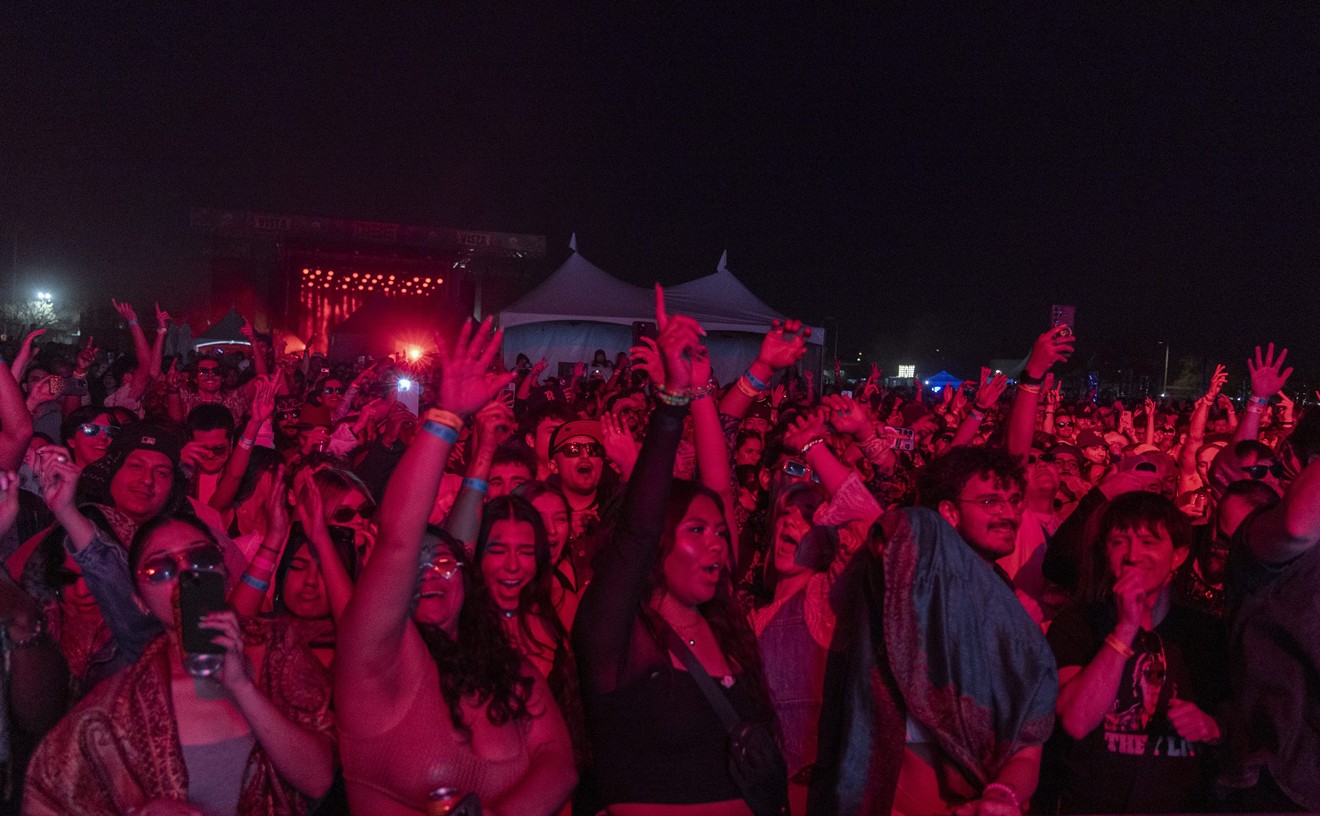In its peak year, 1967, 16 claimed one million copies sold at newsstands, a figure it managed to schmendrake into "The Top Favorite of Over Seven Million Readers" because of "pass-along readership"! 16 still publishes today with considerably less "pass-along readership" and the likes of Hanson emblazoned on its front cover. Mention 16 to someone age 32, and it's the magazine's pre-1975 look she remembers most--those cheery disembodied heads of pop stars plunked down on innocuous cartoon bodies.
Even bad-boy stars like Alice Cooper, Mick Jagger and (shudder, shudder) Dark Shadows' resident vampire Jonathan Frid were depicted happily riding a runaway toboggan with a polar bear or presiding over a picnic blanket near an oversize zebra. Fans of those halcyon days can now relive them twofold; Boulevard Books has just published a fascinating paperback by former 16 editors Randi Reisfeld and Danny Fields titled Who's Your Fave Rave? while Rhino Records has released a like-named CD companion with (count 'em) 16 teen-idol treasures. Spiffy!
In keeping with the myth-preserving tone of the original magazine, Who's Your Fave Rave? includes no up-to-date pix of yesterday's heroes now sporting receding hairlines or dissipated post-12-Step glances. True, there's an unpublished photo of David Cassidy giving the finger twice and the Hudson Brothers peeing into a fountain, but otherwise all the stars are seen as you remember them, even as they reveal their groupie-groping days on the road.
In the pre-Rolling Stone magazine years, 16 was the only viable rock press out there. Every musical act was given "favorite color" consideration and coverage, but after 1967 teen idolatry became a stigma. Yet we don't think of the Byrds, the Doors and the Rolling Stones as teen idols, only as the smiling idiots whose music was the kitsch of death. Is that fair? Join us now, as we count down 10 of the worst teen-torturers of song ever to elicit screams from adolescent girls and gut-wrenching groans from just about everyone else:
10. Frankie Avalon
(years of 16 popularity: 1959-63)
Fabian
(years of 16 popularity: 1959-62)
Why do we equate teen idols with artists of no fixed musical ability? The same reason we equate Frankie Avalon and Fabian in the same breath--these idols were "manufactured" by the same manager, Bob Marcucci, on whom the film The Idolmaker was loosely based. How telling that these two cheap knockoffs of the King were quickly separated from single-digit numbers on the charts once Private Elvis Aron Presley returned to civilian life. Avalon sang his first hit "DeDe Dinah" pinch-holding his nose, a technique many listeners would emulate while suffering through his entire recorded output. Fabian was even less musically accomplished, if that's possible, growling hits like "Tiger" and "Turn Me Loose" with all the finesse of a schoolyard bully shaking you down for your milk money. Without these two, "payola" would've never become a word in the dictionary.
9. Paul Peterson
(years of 16 popularity:
1962-65)
Essentially the first TV star turned teen idol turned recording star to follow in Ricky Nelson's wake. But even Ricky, with a cool do-nothing patriarch like Ozzie, would never have warbled the saccharine "My Dad" with a straight face like PP did. And Carl Betz wasn't even his darned dad! Damn suckup!
8. Patty Duke
(years of 16 popularity:
1964-65)
Here's another twist--an Oscar-winning movie star (The Miracle Worker) turned TV star turned teen-idol clone of Lesley Gore. Too bad there wasn't a Miracle Worker present in the studio. On a session outtake from Duke's Legendary Masters Series CD, the producer clearly instructs Patty "if it's wrong, let's make it LOUD wrong." Even double-tracked, the Identical Cousin sounds as meek as Lisa Simpson on her lone Top 10 hit "Don't Just Stand There," with a spoken bridge ("If it's a game I don't want to play it!/And if it's goodbye/Why don't you just SAY IT?") that showcases the same histrionics she'd deploy in the '80s when portraying herself in her made-for-TV biopic.
7. Dino, Desi and Billy
(years of 16 popularity: 1965-70)
Dino, Desi and Billy were rock's first supergroup, but only because their parents were SUPER! Desi was Lucille Ball and Desi Arnaz's little drummer boy, Dino was Dean Martin's spawn and Billy's folks were . . . uhhh, not famous. With all we know about the hell that sons of celebrity parents endure, why then couldn't any of these boys manage even a meager scream on their cover version of "Hang On Sloopy" or muster any real anger on "Get Off My Cloud"? Despite the tough, fuzz-bass overtures of the group's next anthem "The Rebel Kind," Dino's whining sounds not like a punk intent on pissing off his short-haired elders but rather a kid being reprimanded to take out the trash while Shindig was on TV. The hate that catapulted this group to stardom is seismic. Rock's greatest foe, Frank Sinatra, "auditioned" the boys in Dean's living room, presumably with a well-stocked wet bar close by. After hearing a mere three songs, Sinatra signs the kids to his label Reprise. That the Chairman of the Board and his pals believed that kids couldn't tell the difference between real rock 'n' roll and the rancid racket their rich and pampered offspring was making in the garage speaks volumes about the generation gap.
6. The Brady Bunch
(years of 16 popularity: 1970-73)
As responsible parents, Carol and Mike should've 86'ed the Brady Six after hearing their kids mangle the show's theme song. And then they should've fired Alice for showing them which end to blow in to a pitch pipe. There wasn't one Brady in the sextet who could be counted on to find the right note at any given time. And two of 'em even had spinoff solo singing careers! Most cringe-worthy Brady moment--the flaky cover of "American Pie." If the music hadn't died yet, this would've sent it spiraling into cardiac arrest.
5. Leif Garrett
(years of 16 popularity: 1975-80)
Mispronouncing Garrett's first name is about the only way to extract "life" from his limp discography. (Hint: His name rhymes with "safe.") His albums are treacherous mine fields of tepid disco numbers like "I Was Made for Dancin'" and bad Beach Boys covers that make people grateful for the little rills of silence they put in between cuts. One suspects that the popular teen-idol practice of "sweetening" his voice (i.e., masking it behind background session singers) is in practice here since Garrett's voice sounds different on almost every cut. Undistinguished, but still, different. If you can name what unsuccessful TV show this idol was plucked from, you already know way too much about Leif.
4. John Travolta
(years of 16 popularity: 1976-78)
Even though Travolta's mug is plastered on one of the biggest-selling albums of all time, the Saturday Night Fever soundtrack featured not even a single note of Travolta singing. Unfortunately, his two embarrassing teen-idol albums contained more than their share. Both LPs were repackaged under the misleading title of Travolta Fever in the hopes some brain-dead Vinnie Barbarino fans would mistakenly purchase it and somehow not miss the Bee Gees. On Travolta's only chart hit "Let Her In," the Sweat Hog barely stays on top of the studio mike long enough to deliver the last syllable of each line. He sounds very much like someone in the grips of a posthypnotic suggestion waiting for a bell to spur him into action or at least wake him up for Mr. Kotter's next class.
3. Jimmy and Kristy McNichol
(years of 16 popularity: 1977-80)
Kristy's the one with the deep booming voice, right? If one had to isolate the worst moment here that doesn't have anything to do with desecrating golden oldies, it's "He's a Dancer": "He's the king of moves and the music is his crown." Wonder what his throne is?
2. Pat Boone
(years of 16 popularity: 1958-62)
Though Pat excelled at singing ballads like "April Love," when he applied that same smooth baritone to rock tunes, he bordered on musical retardation. According to the liner notes of his first LP, Boone seriously toyed with the idea of changing Fats Domino's "Ain't That a Shame" to "Isn't That a Shame" to make it grammatically acceptable. He did change a line in "Tutti Frutti" from "Boy, you don't know what she's doing to me" to "Pretty little Suzy is the girl for me." Reasons Pat, "it worked just as well. The kids didn't care." Guess that's why when Pat took to metal, he wore rub-on tattoos and sang "Enter Sandman" like it was "April Love." The kids didn't care. No, Pat couldn't rock. Not for shit. Not for anyone.
1. Bobby Sherman
(years of 16 popularity: 1969-71)
Here was the ultimate nice idol, always concerned about giving his fans "quality Bobby Sherman." The gatefold sleeve to his Here Comes Bobby album opened up to a life-size poster of Bobby, if you were three feet tall. With Love, Bobby came loaded with a scrapbook album of maddeningly dull photos ("At Age 6, He Liked to Pose Next to Flowers," "Telegram Sent to Bobby From His Baseball Coach"--even an elementary school Safety Certificate of Merit is deemed worthy for inclusion. What you wouldn't give to see a bad report card!). Bobby reportedly still maintains friendships with old fans to the extent of accompanying one to her 10th-year high school reunion in 1988. Try picturing Davy Jones doing that now without insisting on money up front!
Part of Bobby's appeal was his selflessness. Half the Bobby pix published in his 1996 autobiography Still Remembering You have him pointing at the camera, as if to divert attention away from himself and back toward you, the ever-lovin' fan! Even describing his darkest day in 1979 after his wife and kids left him, Shermy still manages to sound like a polite, well-mannered 16 Dream Date: "I drank a lot of Scotch and the next thing I remember I woke up under the pool table. I don't remember how I got there and that scared me." Sorta sounds like Keith Richards' best day, don't it?
Fave Rave authors agree that "if you could gather all the components of a perfect idol and download them onto a computer, Bobby Sherman would appear on the screen." But doncha dare download any soundbites! Anytime Mr. Easy Come, Easy Go destroyed a perfect smile by separating his choppers to sing, the sound emanating was not unlike someone yelping after a runaway St. Bernard (remember "Hey, Little Woman"?). It's the two allotted showcases for Bobby's songwriting on each album that reveal the inner Bobby girls read 16 to know. He'd progress to a reasonable facsimile of Rod McKuen by album four's "Runaway" ("I runaway with my dreams 'til the light my eyes can see disappears behind the visions of my mind." Whaaa?), but on his eponymous debut, he already had enough confidence to tackle two weighty subjects--"Love" and "Time."
Bobby on "Love": "I told you to be my bride/Still you're near my every side/We'll just love each other 'til all the signs of love are gone."
Bobby on "Time": "We all die from Time/No matter who you are, you answer to Time/Chucka-chicka-chucka-chicka, chucka-chicka-chucka-chicka." That's Bobby imitating a clock! Even David Bowie never thought of doing that. When Bobby later groans, "I bet in a year we all run out of time," he could've been speaking about his colleagues in 16. In a year, he'd have David Cassidy and the Osmonds breathing down his neck and they'd have the Fonz and the Bay City Rollers to worry about soon after that. Chucka-chicka-chucka-chicka, indeed!









